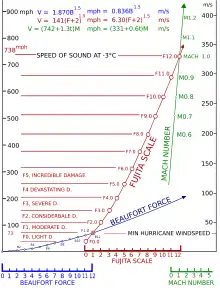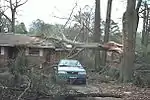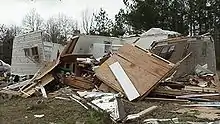Fujita scale
The Fujita scale (F-Scale; /fuˈdʒiːtə/), or Fujita–Pearson scale (FPP scale), is a scale for rating tornado intensity, based primarily on the damage tornadoes inflict on human-built structures and vegetation. The official Fujita scale category is determined by meteorologists and engineers after a ground or aerial damage survey, or both; and depending on the circumstances, ground-swirl patterns (cycloidal marks), weather radar data, witness testimonies, media reports and damage imagery, as well as photogrammetry or videogrammetry if motion picture recording is available. The Fujita scale was replaced with the Enhanced Fujita scale (EF-Scale) in the United States in February 2007. In April 2013, Canada adopted the EF-Scale over the Fujita scale along with 31 "Specific Damage Indicators" used by Environment Canada (EC) in their ratings.[1][2]
| Scale | Speed | Damage |
|---|---|---|
| F0 | < 73 mph | Light |
| F1 | 73–112 mph | Moderate |
| F2 | 113–157 mph | Considerable |
| F3 | 158–206 mph | Severe |
| F4 | 207–260 mph | Devastating |
| F5 | 261–318 mph | Incredible |
Background
The scale was introduced in 1971 by Ted Fujita of the University of Chicago, in collaboration with Allen Pearson, head of the National Severe Storms Forecast Center/NSSFC (currently the Storm Prediction Center/SPC). The scale was updated in 1973, taking into account path length and width. In the United States, starting in the late 1970s,[3] tornadoes were rated soon after occurrence. The Fujita scale was applied retroactively to tornadoes reported between 1950 and the adoption of the scale in the National Oceanic and Atmospheric Administration (NOAA) National Tornado Database. Fujita rated tornadoes from 1916 to 1992[4][5] and Tom Grazulis of The Tornado Project retroactively rated all known significant tornadoes (F2–F5 or causing a fatality) in the U.S. back to 1880.[6] The Fujita scale was adopted in most areas outside of the United Kingdom.
On February 1, 2007, the Fujita scale was decommissioned, and the Enhanced Fujita Scale was introduced in the United States.[7] The new scale more accurately matches wind speeds to the severity of damage caused by the tornado.
Though each damage level is associated with a wind speed, the Fujita scale is effectively a damage scale, and the wind speeds associated with the damage listed aren't rigorously verified. The Enhanced Fujita Scale was formulated due to research that suggested that the wind speeds required to inflict damage by intense tornadoes on the Fujita scale are greatly overestimated. A process of expert elicitation with top engineers and meteorologists resulted in the EF scale wind speeds, but these are biased to United States construction practices. The EF scale also improved damage parameter descriptions.
Derivation

The original scale as derived by Fujita was a theoretical 13-level scale (F0–F12) designed to smoothly connect the Beaufort scale and the Mach number scale. F1 corresponds to the twelfth level of the Beaufort scale, and F12 corresponds to Mach number 1.0. F0 was placed at a position specifying no damage (approximately the eighth level of the Beaufort scale), in analogy to how Beaufort's zeroth level specifies little to no wind. From these wind speed numbers, qualitative descriptions of damage were made for each category of the Fujita scale, and then these descriptions were used to classify tornadoes.[8]
At the time Fujita derived the scale, little information was available on damage caused by wind, so the original scale presented little more than educated guesses at wind speed ranges for specific tiers of damage. Fujita intended that only F0–F5 be used in practice, as this covered all possible levels of damage to frame homes as well as the expected estimated bounds of wind speeds. He did, however, add a description for F6, which he called an "inconceivable tornado", to allow for wind speeds exceeding F5 and possible advancements in damage analysis that might show it.[9] In total, two tornadoes received the rating of F6, but both were later downgraded to F5.[10]
Based on aerial photographs of the damage it caused, Fujita assigned the strongest tornado of the 1974 Super Outbreak, which affected Xenia, Ohio, a preliminary rating of F6 intensity ± 1 scale.[11] The 1977 Birmingham–Smithfield F5 tornado's damage was surveyed by Ted Fujita and he “toyed with the idea of rating the Smithfield tornado an F6.”[12] In 2001, tornado expert Thomas P. Grazulis stated in his book F5–F6 Tornadoes; "In my opinion, if there ever was an F6 tornado caught on video, it was the Pampa, Texas tornado of 1995".[13] In 2023, it was announced by the Storm Prediction Center and National Weather Service Norman, Oklahoma that the 1970 Lubbock tornado was originally rated F6, which was later downgraded to its official rating of F5.[14]
Furthermore, the original wind speed numbers have since been found to be higher than the actual speeds required to incur the damage described at each category. The error manifests itself to an increasing degree as the category increases, especially in the range of F3 through F5. NOAA notes that "precise wind speed numbers are actually guesses and have never been scientifically verified. Different wind speeds may cause similar-looking damage from place to place—even from building to building. Without a thorough engineering analysis of tornado damage in any event, the actual wind speeds needed to cause that damage are unknown."[9] Since then, the Enhanced Fujita Scale has been created using better wind estimates by engineers and meteorologists.
Parameters
The six categories are listed here, in order of increasing intensity.
- The rating of any given tornado is of the most severe damage to any well-built frame home or comparable level of damage from engineering analysis of other damage.
- Since the Fujita scale is based on the severity of damage resulting from high winds, a tornado exceeding F5 is an immeasurable theoretical construct. Frame-home structural damage cannot exceed total destruction and debris dispersal, which constitutes F5 damage. A tornado with wind speeds greater than 319 miles per hour (513 km/h) is theoretically possible, and the 1999 Bridge Creek-Moore Tornado may have been such an event, but no such wind speed has ever been recorded and that measurement was not near ground level.
| Scale | Wind speed estimate[7] | Frequency[15] | Potential damage[7] | ||
| mph | km/h | ||||
| F0 | 40–72 | 64–116 | 44.14% | Light damage.Small trees are blown down and bushes are uprooted. Shingles are ripped off roofs, windows in cars and buildings are blown out, medium to large branches snapped off of large trees, sheds are severely damaged, and loose small items are tossed and blown away (i.e. lawn chairs, plastic tables, sports equipment, mattresses). Barns are damaged. Paper and leaves lifted off the ground. |  |
| F1 | 73–112 | 117–180 | 34.24% | Moderate damage.Roofs stripped from shingles or planting. Small areas of the roof may be blown off the house. Doors and garage doors blown in, siding ripped off houses, mobile homes flipped or rolled onto their sides, small trees uprooted, large trees snapped or blown down, telephone poles snapped, outhouses and sheds blown away. Cars occasionally flipped or blown over, and moderate roof and side damage to barns. Corn stalks are slightly bent and stripped of leaves. |  |
| F2 | 113–157 | 181–253 | 16.17% | Significant damage.Whole roofs ripped off frame houses, interiors of frame homes damaged, small and medium trees uprooted. Weak structures such as garages, barns, and mobile homes are completely destroyed. Cars lifted off the ground. Large trees snapped. |  |
| F3 | 158–206 | 254–332 | 4.35% | Severe damage.Roofs and numerous outside walls blown away from frame homes, all trees in its path uprooted and/or lofted, two-story homes have their second floor destroyed, highrises have many windows blown out, radio towers blown down, metal buildings (i.e. factories, power plants, and construction sites) are heavily damaged, sometimes completely destroyed. Large vehicles such as tractors, buses, and forklifts are blown from their original positions. Severe damage to large structures such as shopping malls. Trains flipped or rolled onto their sides. |  |
| F4 | 207–260 | 333–418 | 1.00% | Devastating damage.Trees are partially debarked, cars are mangled and thrown in the air, frame homes are completely destroyed and some may be swept away, moving trains are blown off railroad tracks, and barns are leveled. High-rises are significantly damaged. |  |
| F5 | 261–318 | 419–512 | 0.10% | Incredible damage.Nearly all buildings aside from heavily built structures are destroyed. Cars are mangled and thrown hundreds, possibly thousands of yards away. Frame homes, brick homes, and small businesses are swept away, trees debarked, corn stalks flattened or ripped out of the ground, skyscrapers sustain major structural damage, grass ripped out of the ground. Wood and any small solid material become dangerous projectiles. |  |
Pearson scales
In 1973, Allen Pearson added additional path length and path width parameters to the Fujita scale. Under this version, each tornado would be assigned one Fujita scale rating and two Pearson scale ratings. For example, a tornado rated F4 based on damage with a path length of 63 miles (101 km) and a path width of 800 yards (730 m) would be rated F,P,P 4,4,4. Use of the Pearson scales was not widespread, however, and it remained more common to simply list a tornado's path length and path width directly.[6]
| Scale | Path length | Path width |
|---|---|---|
| – | <0.3 mi (0.48 km) | <6 yd (5.5 m) |
| P0 | 0.3–0.9 mi (0.48–1.45 km) | 6–17 yd (5.5–15.5 m) |
| P1 | 1.0–3.1 mi (1.6–5.0 km) | 18–55 yd (16–50 m) |
| P2 | 3.2–9.9 mi (5.1–15.9 km) | 56–175 yd (51–160 m) |
| P3 | 10–31 mi (16–50 km) | 176–566 yd (161–518 m) |
| P4 | 32–99 mi (51–159 km) | 0.3–0.9 mi (0.48–1.45 km) |
| P5 | 100–315 mi (161–507 km) | 1.0–3.1 mi (1.6–5.0 km) |
Rating classifications
| F0 | F1 | F2 | F3 | F4 | F5 |
|---|---|---|---|---|---|
| Weak | Strong | Violent | |||
| Significant | |||||
| Intense | |||||
For purposes such as tornado climatology studies, Fujita scale ratings may be grouped into classes.[6][16][17]
Decommissioning in the U.S.
The Fujita scale, introduced in 1971 as a means to differentiate tornado intensity and path area, assigned wind speeds to damage that were, at best, educated guesses.[18] Fujita and others recognized this immediately and intensive engineering analysis was conducted through the rest of the 1970s. This research, as well as subsequent research, showed that tornado wind speeds required to inflict the described damage were actually much lower than the F-scale indicated, particularly for the upper categories. Also, although the scale gave general descriptions of damage a tornado could cause, it gave little leeway for strength of construction and other factors that might cause a building to sustain more damage at lower wind speeds. Fujita tried to address these problems somewhat in 1992 with the Modified Fujita Scale,[19] but by then he was semi-retired and the National Weather Service was not in a position to update to an entirely new scale, so it went largely unenacted.[20]
In the United States, on February 1, 2007,[1] the Fujita scale was decommissioned in favor of what scientists believe is a more accurate Enhanced Fujita Scale. The meteorologists and engineers who designed the EF Scale believe it improves on the F-scale on many counts. It accounts for different degrees of damage that occur with different types of structures, both manmade and natural. The expanded and refined damage indicators and degrees of damage standardize what was somewhat ambiguous. It also is thought to provide much better estimates of wind speeds and sets no upper limit on the wind speeds for the highest level, EF5. Environment Canada began using the Enhanced Fujita scale in Canada on April 1, 2013.[21] The U.S. and Canada are the only countries to officially adopt the Enhanced Fujita scale.
See also
- Enhanced Fujita scale
- International Fujita scale
- Lists of tornadoes and tornado outbreaks
- Rohn Emergency Scale for measuring the magnitude (intensity) of any emergency
- Saffir–Simpson Hurricane Scale
- Severe weather terminology (United States)
- Tornado intensity and damage
- Tornado records
- TORRO scale
- Wind engineering
References
- "Fujita Tornado Damage Scale". spc.noaa.gov. Retrieved May 27, 2017.
- "Fujita Scale – Tornado Damage Scale". factsjustforkids.com. Retrieved June 14, 2019.
- Edwards, Roger; LaDue, James G.; Ferree, John T.; Scharfenberg, Kevin; Maier, Chris; Coulbourne, William L. (May 1, 2013). "Tornado Intensity Estimation: Past, Present, and Future" (PDF). Bulletin of the American Meteorological Society. 94 (5): 641–653. Bibcode:2013BAMS...94..641E. doi:10.1175/BAMS-D-11-00006.1. ISSN 1520-0477. S2CID 7842905.
- McDonald, James R. (2001). "American Meteorological Society". Bulletin of the American Meteorological Society. 82 (1): 63–72. Bibcode:2001BAMS...82...63M. doi:10.1175/1520-0477(2001)000<0063:TTFHCT>2.3.CO;2.
- McCarthy, Daniel. "NWS Tornado Surveys and the Impact on the National Tornado" (PDF). www.spc.noaa.gov.
- Grazulis, Thomas P. (July 1993). Significant Tornadoes 1680–1991. St. Johnsbury, Vermont: The Tornado Project of Environmental Films. ISBN 978-1-879362-03-1.
- Fujita Tornado Damage Scale Storm Prediction Center. Accessed May 20, 2009.
- "Storm Prediction Center". spc.noaa.gov. Retrieved May 27, 2017.
- Tornado FAQ. Storm Prediction Center. Site accessed June 27, 2006.
- Anna, Carly (October 26, 2023). "Explaining the 'Inconceivable F6' Tornado" (Video). YouTube. @CarlyAnnaWx. Archived from the original on October 26, 2023. Retrieved October 26, 2023.
- Fujita, T. Theodore (1974). "Jumbo Tornado Outbreak of 3 April 1974" (PDF).
- "April 4, 1977, Smithfield F5 Tornado". National Weather Service. Retrieved April 8, 2022.
- Thomas P. Grazulis (2021). F5-F6 Tornadoes. The Tornado Project.
- Roger Edwards (SPC); Matthew S. Elliott (SPC); Patrick T. Marsh (SPC; Douglas A. Speheger (NWS). "Errors, Oddities and Artifacts in U.S. Tornado Data, 1995–2021" (PDF). Storm Prediction Center Publications: 1–10. Retrieved January 11, 2023.
- "Storm Prediction Center WCM Data". Storm Prediction Center. Retrieved September 15, 2021.
- The Fujita Scale of Tornado Intensity, Archived at: Archived December 30, 2011, at the Wayback Machine
- Brooks, Harold. "index". nssl.noaa.gov. Archived from the original on October 4, 2012. Retrieved May 27, 2017.
- Fujita, Tetsuya Theodore (1971). Proposed characterization of tornadoes and hurricanes by area and intensity. Chicago: University of Chicago.
- Center, Storm Prediction. "NOAA's NWS Storm Prediction Center". www.spc.noaa.gov. Retrieved May 27, 2017.
- Fujita, Tetsuya Theodore (1992). Memoirs of an Effort to Unlock the Mystery of Severe Storms. Chicago: University of Chicago.
- Assessing tornado damage: EF-scale vs. F-scale Archived April 27, 2013, at the Wayback Machine
Bibliography
- Marshall, Timothy P. (2001). "Birth of the Fujita Scale". Storm Track. 24 (3): 6–10.
- Edwards, Roger; J. G. LaDue; J. T. Ferree; K. Scharfenberg; C. Maier; W. L. Coulbourne (2013). "Tornado Intensity Estimation: Past, Present, and Future". Bull. Amer. Meteor. Soc. 94 (5): 641–653. Bibcode:2013BAMS...94..641E. doi:10.1175/BAMS-D-11-00006.1. S2CID 7842905.